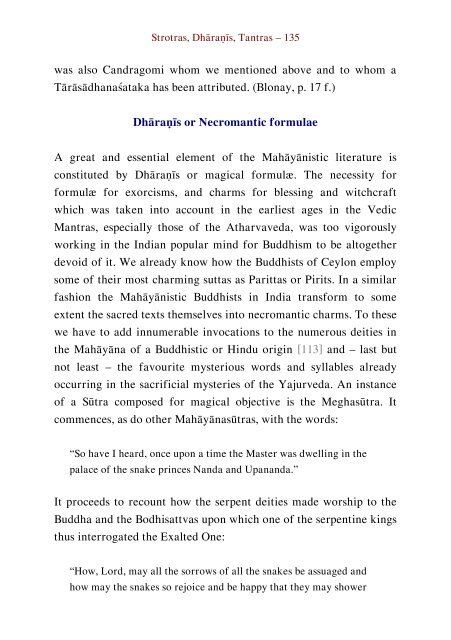Literary History of Sanskrit Buddhism
A study by J. K. Nariman of Sanskrit Buddhism from the Early Buddhist Tradition up to the Mahayana texts proper.
A study by J. K. Nariman of Sanskrit Buddhism from the Early Buddhist Tradition up to the Mahayana texts proper.
You also want an ePaper? Increase the reach of your titles
YUMPU automatically turns print PDFs into web optimized ePapers that Google loves.
Strotras, Dhāraṇīs, Tantras – 135<br />
was also Candragomi whom we mentioned above and to whom a<br />
Tārāsādhanaśataka has been attributed. (Blonay, p. 17 f.)<br />
Dhāraṇīs or Necromantic formulae<br />
A great and essential element <strong>of</strong> the Mahāyānistic literature is<br />
constituted by Dhāraṇīs or magical formulæ. The necessity for<br />
formulæ for exorcisms, and charms for blessing and witchcraft<br />
which was taken into account in the earliest ages in the Vedic<br />
Mantras, especially those <strong>of</strong> the Atharvaveda, was too vigorously<br />
working in the Indian popular mind for <strong>Buddhism</strong> to be altogether<br />
devoid <strong>of</strong> it. We already know how the Buddhists <strong>of</strong> Ceylon employ<br />
some <strong>of</strong> their most charming suttas as Parittas or Pirits. In a similar<br />
fashion the Mahāyānistic Buddhists in India transform to some<br />
extent the sacred texts themselves into necromantic charms. To these<br />
we have to add innumerable invocations to the numerous deities in<br />
the Mahāyāna <strong>of</strong> a Buddhistic or Hindu origin [113] and – last but<br />
not least – the favourite mysterious words and syllables already<br />
occurring in the sacrificial mysteries <strong>of</strong> the Yajurveda. An instance<br />
<strong>of</strong> a Sūtra composed for magical objective is the Meghasūtra. It<br />
commences, as do other Mahāyānasūtras, with the words:<br />
“So have I heard, once upon a time the Master was dwelling in the<br />
palace <strong>of</strong> the snake princes Nanda and Upananda.”<br />
It proceeds to recount how the serpent deities made worship to the<br />
Buddha and the Bodhisattvas upon which one <strong>of</strong> the serpentine kings<br />
thus interrogated the Exalted One:<br />
“How, Lord, may all the sorrows <strong>of</strong> all the snakes be assuaged and<br />
how may the snakes so rejoice and be happy that they may shower


















